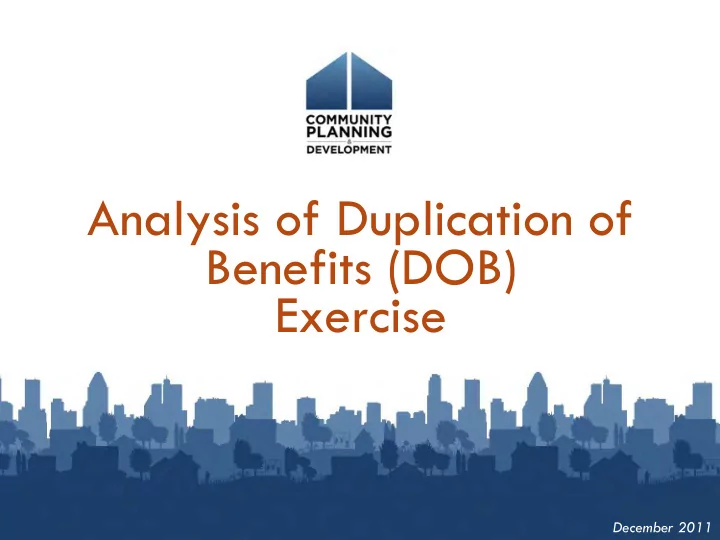

Analysis of Duplication of Benefits (DOB) Exercise December 2011
Refer to the Notice The DOB process: A. Determine need & duplicative benefits B. Calculate eligible CDBG-DR award C. Address remaining unmet need (if applicable)
A. Determine Need & Duplicative Benefits 1. Assess need Post-disaster estimated damages = $115,000 Estimated cost to repair home at time of application = $85,000 This takes into account the other funds (i.e., $15,000 of FEMA assistance, $5,000 bank loan, and $10,000 in savings) used for repairs prior to the submission of the CDBG-DR application AMI of the family is irrelevant (can use urgent need CDBG national objective)
A. Determine Need & Duplicative Benefits 2. Identify total assistance available to the applicant Total assistance = $122,500
A. Determine Need & Duplicative Benefits 3. Exclude: a) Funds for a different purpose or general, non-specific purpose b) Funds for same purpose, different (eligible) use c) Funds not available d) Private loans e) Other assets or lines of credit
A. Determine Need & Duplicative Benefits a) Exclude funds for a different purpose or general, non-specific purpose Exclude item (1) = $2,500 Item (1) is for a general purpose (disaster recovery) and so is not considered duplicative to the potential CDBG-DR award for rehabilitation assistance
A. Determine Need & Duplicative Benefits b) Exclude funds for same purpose, different (eligible) use Exclude item (2) = $10,000 Funds spent on interim housing constitute a different (eligible) use of funds and do not duplicate assistance provided for rehabilitation
A. Determine Need & Duplicative Benefits c) Exclude funds not available Exclude item (4) = $40,000 Funds used for a forced mortgage payoff are not considered duplicative to rehabilitation assistance; since they can’t be used for repairs, the applicant’s need for safe/suitable housing still exists
A. Determine Need & Duplicative Benefits d) Exclude private loans Exclude item (6) = $5,000 Generally exclude private loans when calculating a DOB, but where private loan funds have been used prior to the award of CDBG-DR funds, they may affect the need determination even though they aren’t considered duplicative
A. Determine Need & Duplicative Benefits d) Exclude private loans In this case, item (6) can be excluded because the revised estimate ($85,000) addresses the need remaining after the use of the loan for the rehab
A. Determine Need & Duplicative Benefits e) Exclude other assets or lines of credit Exclude item (7) = $30,000 (Savings) Generally exclude other assets or lines of credit when calculating a DOB, but where they have been used prior to the award of CDBG-DR funds, they may affect the need determination even though they aren’t considered duplicative
A. Determine Need & Duplicative Benefits e) Exclude other assets or lines of credit In this case, exclude the $20,000 not spent ($30,000 award - $10,000 spent); other assets or lines of credit not used by the applicant are not duplicative to rehabilitation assistance Also exclude the $10,000 spent – the estimated cost to repair the home ($85,000) illustrates the need remaining after the $10,000 was used for repairs
A. Determine Need & Duplicative Benefits Exclude anything else? In this situation, exclude FEMA funds already used for repairs (item 3, $15,000) because the rehabilitation estimate at the time of application ($85,000) takes into account the need remaining after the use of those funds Applicant must document that the funds were used for the rehabilitation Contrast: if a post-disaster estimate ($115,000) was the only estimate, the FEMA funds would not be excluded
A. Determine Need & Duplicative Benefits 3. Summary of exclusions Item (1) = $ 2,500 Item (2) = $10,000 Item (3) = $15,000 Item (4) = $40,000 Item (6) = $ 5,000 Item (7) = $30,000 $102,500
A. Determine Need & Duplicative Benefits 3. Need determined duplicative Total assistance of $ 122,500 - Total exclusions of $ 102,500 Duplicative amount of $20,000*
A. Determine Need & Duplicative Benefits 3. So what is duplicative? Part of item (3) ($5,000) – FEMA funds provided for the purpose of rehabilitation, but not yet used for the home repairs – are duplicative as they are available to the applicant for the repair of the home $15,000 of FEMA assistance already used would be duplicative if the use of those funds for repairs could not be documented/substantiated
A. Determine Need & Duplicative Benefits 3. So what is duplicative? Item (5) ($15,000) – SBA funds provided for the purpose of rehabilitation Although not spent by the homeowners, the SBA funds are available for their use and must be considered as duplicative because they address the same repair/rehabilitation need
B. Calculate Award Basic framework: 1. Identify Applicant’s Total Need Prior to Any Assistance $115,000 2. Identify Applicant’s Need at time of Application $ 85,000 3. Identify All Potentially Duplicative Assistance $ 122,500 4. Deduct Assistance Determined to be Duplicative $ 20,000 5. Maximum Eligible Award (Item 2 less Item 4) $ 65,000 6. Program Cap (if applicable) n/a 7. Final Award (lesser of Items 5 and 6) $ 65,000
Good Practices Identification of applicant’s need at time of application Purpose? Take into account whether circumstances have affected applicant’s original need (e.g., other funds available and used by the applicant, further damage, etc.) In some cases, the applicant’s need at the time of application may be the same as the original need
Good Practices If significant time lapse between application and award, verify assistance needed prior to providing funds (e.g., through an appraisal or physical examination) Timely estimate more accurately assesses need, but remember to exclude assistance applicant can document was used prior to estimate
Good Practices Private loans – underwriting When assisting businesses, a grantee may consider construction and bridge loans for underwriting purposes, although they need not be considered duplicative Ex. Company X has damage of $100,000 and has been approved for a private loan ($50,000, no funds yet drawn). Grantee may take private loan into account for underwriting, but need not consider it duplicative
Questions?
Recommend
More recommend